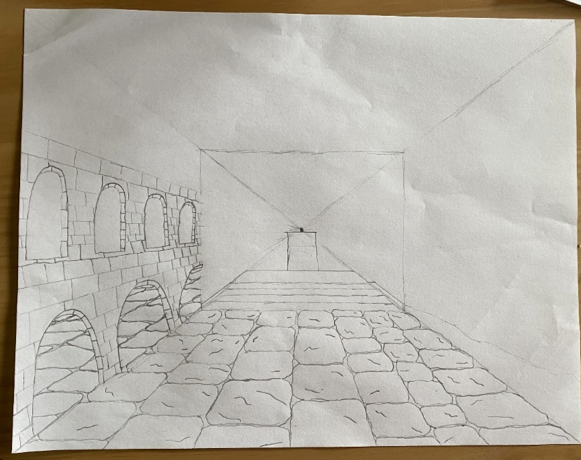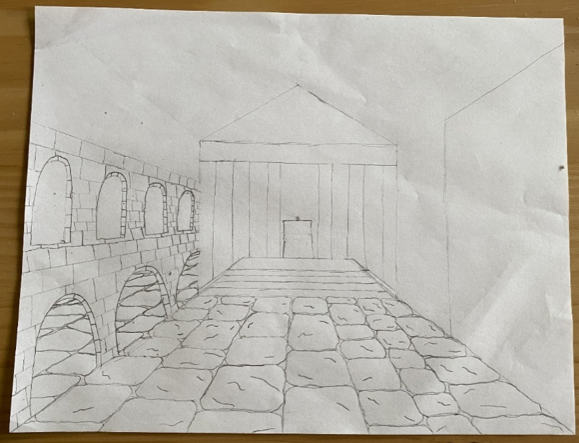Activity Guide by Kate Kwasneski, Intern, Grinnell College Museum of Art
Giovanni Battista Piranesi was an artist who lived in Italy in the 1700s. Throughout his career, he focused on etchings of Rome, and the Grinnell College Museum of Art has several of these in our collection.
An etching is a type of print. If you would like to make a print, here is a link to our activity guide on printmaking. To make an etching, an artist puts a waxy coating on a piece of metal, then carves their image into that coating. Acid eats away at the metal where the artist has drawn. When this metal plate is pressed into a piece of paper, it leaves a print!
Piranesi was part of the Neoclassical movement in European art. Classical, in this case, refers to the art and architecture of ancient Rome, and "neo" means new, so Neoclassicism is about a new appreciation for things that look Roman. A lot of art history in Europe can be summed up as whether the artists in the movement wanted to follow the Classical art style or not, and Neoclassicism definitely did.
You can see that Piranesi’s images do not have a lot of color. There are people in them, but those people are dwarfed by the imposing Roman buildings that take up most of the etching. What emotions are in these images? What do you think of the light and shadows?
In these images, Piranesi has used one-point perspective. This technique, which became popular during the Renaissance in Italy, puts the intersection of almost all lines at one point, which is where the name comes from. This way of drawing tricks the eye into thinking the background of the image is further away than the foreground, giving the whole image a sense of depth. Today, I’m going to demonstrate one-point perspective by drawing a Roman scene of my own.
Start by drawing a line from one corner of the paper to the other. Repeat with the other two corners. The point where they intersect will be your vanishing point – most lines that you make in a one-point perspective drawing will intersect at the vanishing point, it’s what makes the drawing look like some parts of it are receding into space. If you drew a straight line across the paper at the vanishing point, it would be the horizon line. You could put your vanishing point wherever you like on the paper, but it’s easiest for me to put it in the center, so that’s what I’ve demonstrated here.
Put a dot on your vanishing point. Make it dark, you will need it to be visible. I put a box around my vanishing point as the start of my center building. It can help to have something in your drawing centered on the vanishing point.
Here I have started to add the cobblestones. Notice how the lines between the rows of cobblestones all intersect at the vanishing point. That’s why the cobblestones in front look closer than the ones in back.
Here I have done the same thing to make an aqueduct. You can see some lines that I have drawn all the way to the vanishing point and have not erased yet, and how these lines make the front of the aqueduct appear farther away.
I’ve added rows of bricks to the aqueduct, and cobblestones underneath it, using the same lines that reach towards the vanishing point. I have erased the parts of the lines that I don’t need.
Here I am adding columns, stairs, and a roof to my central building. Since this building is in the center and on top of the vanishing point, it should be drawn in 2D. It serves as your background, so you only have to use the vanishing point for parts of it that extend outward like the stairs. I have also added the basic shape of my last building on the right.
I’ve added a roof to the building on the right, and you can see the lines that I’ve used to help me make the round parts of the windows. I’ve also started to add more detail to the temple in the center.
Here, I’ve added the lines in for the bricks. This is a particularly good illustration of how the building’s lines all point to the vanishing point.
Here is my completed drawing! Be sure to add details like clouds and trees to your scene. Once you’ve finished, you can leave it black and white like Giovanni Battista Piranesi’s etchings, or you can add color!
When adding color, it’s helpful to first outline all of your lines in black, so the pencil lines don’t disappear under the color.
You can use one-point perspective to draw a Roman scene like Giovanni Battista Piranesi, or you could use it to draw any city, landscape, or room that you wanted to! Be creative with your subject.
Web support:
Daniel Strong
Associate Director and Curator of Exhibitions
Grinnell College Museum of Art













